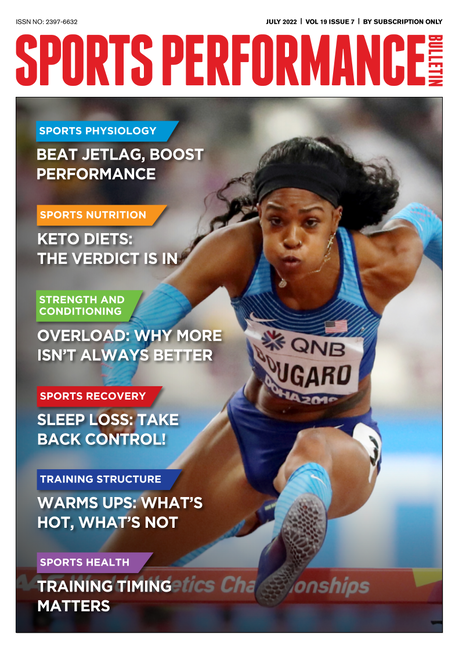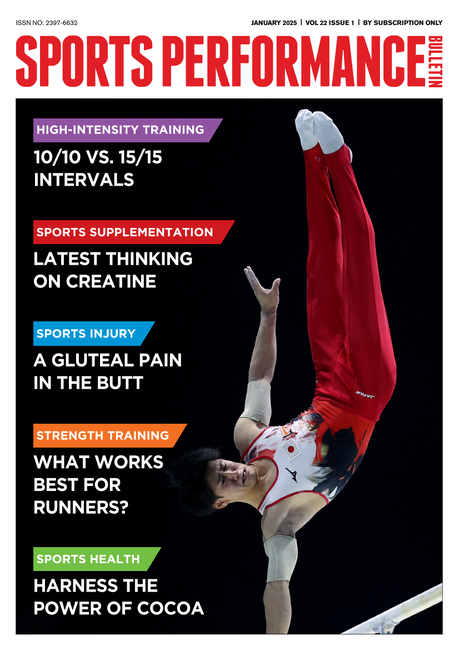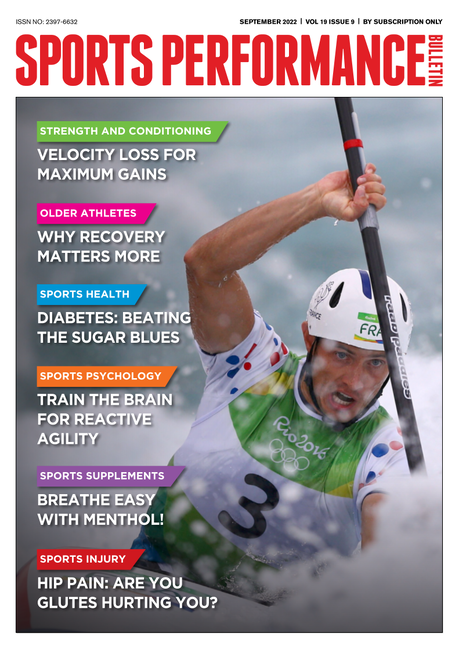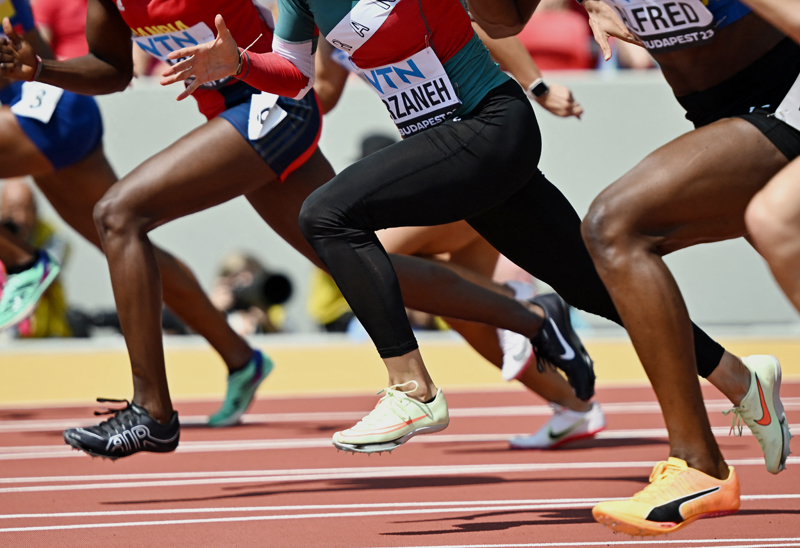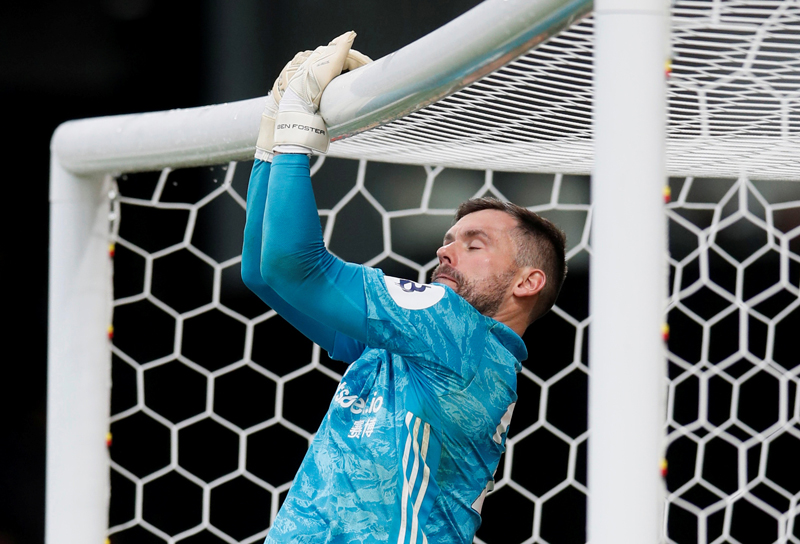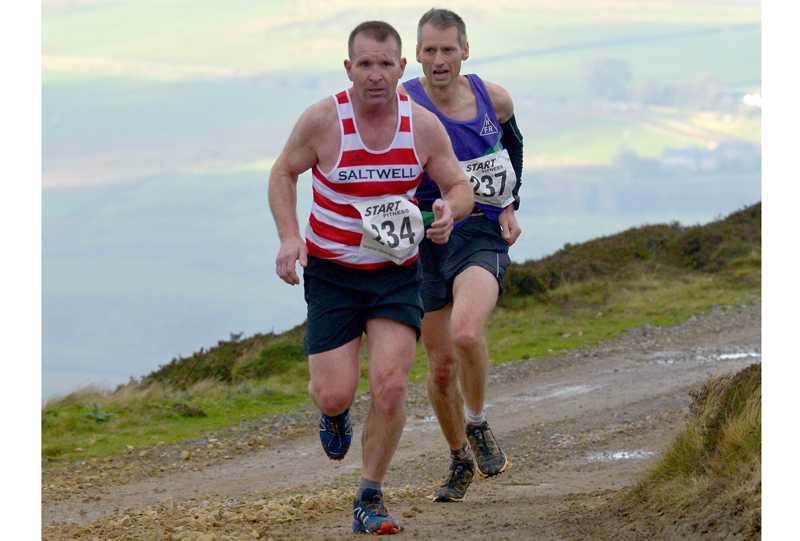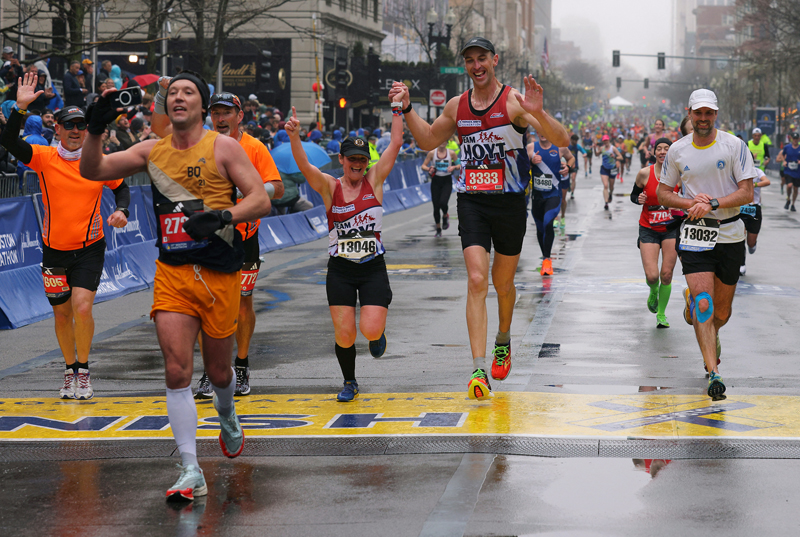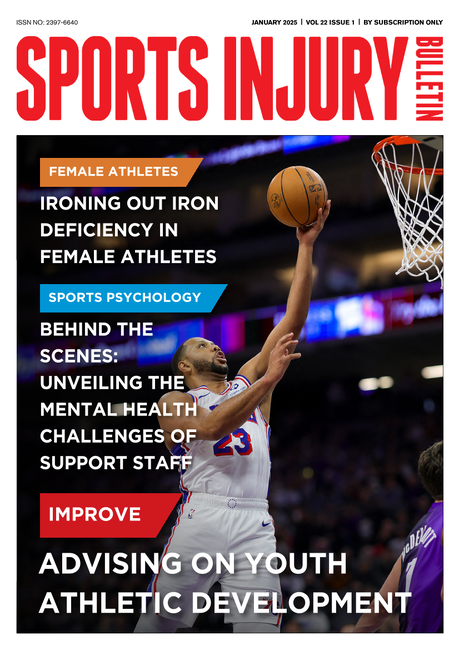You are viewing 1 of your 1 free articles. For unlimited access take a risk-free trial
Fitness Training: VO2 Kinetics and Oxygen Kinetics to Enhance Exercise Performance
The concepts of VO2 kinetics and the O2 deficit
Article at a glance:The concepts of VO2 kinetics and the O2 deficit are introduced;
The importance of VO2 kinetics to exercise performance is explained;
New research on interventions that influence VO2 kinetics is presented;
Practical recommendations for enhancing VO2 kinetics and exercise performance are provided.
The way your body transports and uses oxygen during the initial stages of vigorous exercise might not sound very exciting, but new research suggests that understanding this process and adjusting your pre-race preparation accordingly can result in truly remarkable performance gains. Professor Andy Jones explains
Endurance sports rely primarily on oxidative (aerobic) metabolism for energy supply. It’s not surprising therefore that factors related to oxygen (O2) transport and consumption such as the maximal oxygen uptake (VO2max), economy of movement, and the fraction of the VO2max that can be sustained without a significant accumulation of lactate in the blood (the lactate threshold, LT) are important determinants of endurance exercise performance(1).
These parameters of aerobic fitness are typically measured during an incremental-type exercise test in which the exercise intensity is very low to begin with but then increases progressively until the athlete is unable to continue, and they can provide invaluable information on various aspects of physiological function and the responses to training. However, the manner in which the work rate is imposed during these tests does not accurately reflect the metabolic loading that an athlete will experience at the start of an endurance competition. That’s because at the beginning of a race, an athlete will be required to accelerate up to race pace within just a few seconds. The energetic consequences of this abrupt increase in energy turnover in the working muscles can be profound.
Jargonbuster
Economy of movement
The oxygen cost of exercising at a certain speed or covering a given distance – the lower the oxygen uptake, the more economical an athlete is considered to be
VO2 kinetics
The dynamic behaviour of O2 uptake in the transition from rest to exercise
O2 deficit
The amount of energy which has to be supplied by anaerobic metabolic processes in the early minutes following the start of exercise due to the slow increase in O2 uptake
The oxygen deficit
When the race commences and the athlete quickly accelerates to attain their desired race pace, the energy turnover in the contracting muscle cells, ie the rate at which the high-energy compound ATP is broken down to produce energy and continually re-synthesised, increases abruptly. Indeed, the metabolic rate might increase six- to 10-fold within just a few seconds of the starter’s gun firing!
The muscle’s store of ATP would only be sufficient to allow exercise to be continued for a few seconds but, fortunately, ATP can be re-synthesised in a variety of ways to allow exercise to continue. Ideally, the increased muscle energy requirement would be matched by an instantaneous increase in the rate of energy supply from oxidative metabolism (in which O2 is consumed as a fuel in the muscle and energy is produced for the re-synthesis of ATP). However, as can be seen in figure 1 (overleaf), the energy supplied from oxidative metabolism, as reflected by the measurement of VO2 at the mouth, increases relatively slowly and might only approach the required ‘steady-state’ value after some 2-3 minutes have elapsed.
The behaviour of VO2 following the onset of exercise, including the rate at which it rises, is known as ‘VO2 kinetics’. Because VO2 kinetics is relatively slow, at least when compared to the instantaneous increase in muscle energy turnover, other energy-producing metabolic pathways must be called on to meet the demand. The extent of this demand is contained within the concept of the ‘O2 deficit’ (see figure 1). The O2 deficit simply represents the difference between the amount of energy that is required to perform exercise at the desired intensity for a certain period of time and the amount of energy that is supplied through oxidative metabolism in this same period. It follows therefore that an amount of energy equivalent to the O2 deficit must be supplied almost exclusively by non-oxidative or ‘anaerobic’ processes to make up the shortfall.
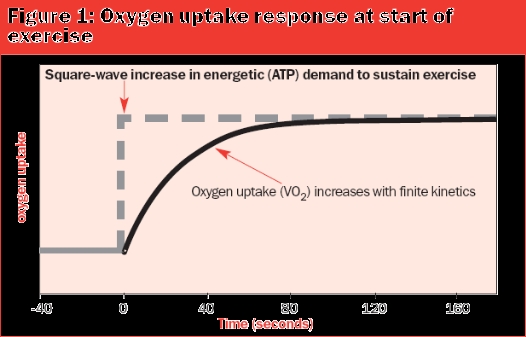
Figure 1: Schematic of the response of VO2 following the onset of constant intensity exercise (time zero). Note that the ATP demand in the contracting muscle cells increases abruptly but that the VO2 response (reflecting the energy supplied by oxidative metabolism) increases relatively slowly, only reaching the required steady-state level after about 2 minutes in this example. The area between the dashed line and the solid line represents the O2 deficit and is the amount of energy that must be supplied by anaerobic processes.
We know that the muscles’ other store of high-energy phosphate compound, called phosphorylcreatine (PCr), falls immediately following the onset of exercise, and is only restored when exercise is stopped. In addition, the process of anaerobic glycolysis, in which muscle glycogen is reduced to lactic acid to liberate energy, is accelerated to meet some of the increased energy demand. While these non-oxidative mechanisms of energy production are essential to allow exercise to continue during the period within which the rate of oxidative metabolism is still increasing towards the required level, there are some negative consequences to their utilisation.
The larger the O2 deficit, the greater the breakdown of muscle high-energy phosphates and the greater the activation of anaerobic glycolysis, which results in reduced concentrations of PCr and possibly ATP, and increased concentrations of metabolic by-products such as ADP, inorganic phosphate, lactate and hydrogen ions in the contracting muscles. Moreover, because anaerobic glycolysis is a relatively inefficient process, muscle glycogen stores will be more rapidly depleted than if the same amount of ATP were generated oxidatively.
All of these factors have been associated with the process of muscle fatigue and thus, the build up of a large O2 deficit in the early minutes of exercise would be expected to adversely affect endurance performance. Even during events such as the marathon (in which the 2-3 minute period over which the initial O2 deficit is incurred might represent only 1-2% of the total exercise duration), it is important to recognise that the biochemical environment established within the muscle cells early in exercise can dictate the subsequent muscle metabolic responses and thus have a major impact on performance later on in the event.
VO2 kinetics in endurance athletes
From the above it is clear that the more rapidly the rate of oxidative metabolism can increase (ie, the faster the VO2 kinetics), the better the likely consequences for endurance exercise performance. Indeed, it is no coincidence that elite endurance athletes have extremely fast VO2 kinetics and that sedentary, elderly, and diseased subjects have much slower VO2 kinetics.
The VO2 response follows a near-exponential time course for the first few minutes following the onset of exercise, and exponential responses can be characterised mathematically using something called the ‘time constant’. Exponential processes are normally defined mathematically and when plotted on a graph against time, have a characteristic growth or decay curve. However, you can think of them as processes in which the rate of growth or decay at any particular time is related to the quantity present or number present at that time. An exponential process is considered to be essentially complete when four time constants have elapsed; thus, for VO2 kinetics, a time constant of 40 seconds (which is characteristic of healthy but untrained subjects) means that a VO2 ‘steady-state’ would be reached within approximately 160 seconds. In contrast, elite endurance athletes have been reported to have time constants of 15 seconds or less (steady-state attained in about 40-60s), while patients with advanced cardiovascular, pulmonary or metabolic diseases have time constants of up to 90 seconds (steady-state attained in about 6 minutes)!
Jargonbuster
Exponential response
A change in rate of growth or decay that is dependent on the quantity already present
Time constant
The time required for 63% of an exponential response to be attained; the response will be complete when four time constants have elapsed
Lactate threshold
The exercise speed above which lactate accumulates in the blood
For the same increase in metabolic rate above the resting rate, the size of the O2 deficit incurred by the elite athlete could be three to four times lower than the young sedentary subject and six to eight times lower than the patient. While the other parameters of aerobic fitness (VO2max, economy, and lactate threshold) will also discriminate between these three types of subject, the importance of these rather dramatic differences in VO2 kinetics in explaining differences in exercise performance should not be underestimated. Indeed, in the patient, the extremely slow VO2 kinetics will lead to rapid muscular fatigue even during mild exercise tasks, thus preventing them from comfortably carrying out the activities of daily living. In the endurance athlete, earlier attainment of the required VO2 for the race will not only reduce the accumulation of metabolites that might impair exercise performance but will also ‘spare’ some of the limited amount of available anaerobic energy for use later in the race, for example in a sprint finish.
Interventions to enhance VO2 kinetics
Training
Perhaps unsurprisingly, the most potent stimulus to enhancing VO2 kinetics is endurance exercise training, which will both enhance O2 supply to muscle and improve the capacity of the muscle to utilise the O2 supplied. As an example of the potency of endurance exercise training in enhancing VO2 kinetics, we recently reported that six weeks of endurance training could significantly speed VO2 kinetics (time constant reduced by about 30%, from approximately 32s to 23s)(2). Such impressive adaptations would certainly be expected to result in enhanced exercise performance.
Interestingly, while it is known that ‘endurance training’ in general terms can enhance VO2 kinetics, it is presently not known whether specific types of training (for example, interval training, or high volume training) can bring about a more impressive adaptation of VO2 kinetics. However, it has been reported that runners who specialise in longer distances have faster VO2 kinetics than those who specialise in middle distance events (3). Paula Radcliffe, the world record holder for the women’s marathon has the fastest reported VO2 kinetics, with a time constant of just 8-9 seconds! However, while these data suggest that VO2 kinetics might be most sensitive to high-volume endurance training, it should be remembered that genetics play a major role in the determination of many aspects of the physiology of champion endurance athletes.
‘Warm-up’ exercise
In already highly trained endurance athletes, the potential for additional training to impact on VO2 kinetics is likely to be limited. However, there is one acute intervention that appears to have the potential to enhance exercise performance by altering the VO2 kinetic response to exercise; namely the warm-up. In this context, however, ‘warm-up’ appears to be something of a misnomer because neither passively elevating muscle temperature using hot baths, nor performing a relatively lengthy but low-intensity warm-up, significantly influences VO2 kinetics(4). Rather, relatively high-intensity ‘prior exercise’, which significantly elevates blood lactate (to a concentration of approximately 2-4 millimoles per litre [2-4 mM]) immediately before the main exercise challenge (ie race), is necessary if VO2 kinetics are to be enhanced.
Several studies have shown that the performance of prior high-intensity exercise leads to an overall speeding of VO2 kinetics, and to a meaningful enhancement of endurance exercise performance (figure 2). For example, researchers working at the Universities of Exeter and Aberystwyth reported that prior high-intensity exercise enhanced the VO2 response and increased the time-to-exhaustion by as much as 30-60% during subsequent near maximal intensity exercise (5). It is noteworthy that the scale of the improvement in performance resulting from this simple procedure was considerably greater than the improvements caused by illegal practices such as EPO abuse.
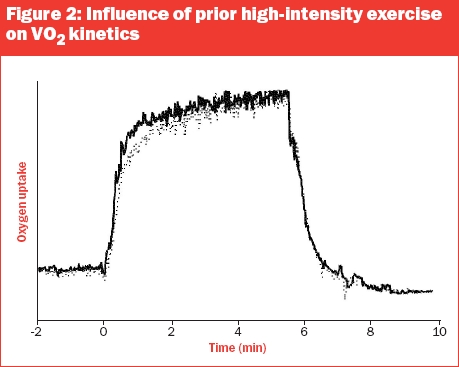
Figure 2: The influence of prior high-intensity exercise on VO2 kinetics during subsequent high-intensity exercise. The dashed line represents the response of VO2 to an initial bout of high-intensity exercise performed without any preceding warmup exercise, while the solid line represents the response to an identical bout of exercise performed 6-10 minutes later. Note that, overall, the VO2 kinetics appear to be speeded in the second exercise bout. This favourable change in VO2 kinetics is associated with enhanced exercise performance.
Although commencing a race with elevated blood lactate values might at face value appear to be unwise, the role of acidosis per se, in eliciting fatigue has recently been questioned(6). Exactly why the performance of prior high-intensity exercise should result in a favourable alteration of VO2 kinetics is not entirely clear but there are a number of possible explanations:
The accumulation of several of the by-products of high-intensity exercise, including lactic acid, will increase muscle blood flow and thus make more O2 readily available to muscle;
It’s likely that the performance of prior high-intensity exercise will ‘prime’ the muscle mitochondria, thereby reducing the inertia to increasing oxidative metabolism within the muscle cells themselves;
It appears that prior high-intensity exercise favourably alters the pattern of muscle fibre recruitment during subsequent exercise with consequent positive effects on muscle performance(7).
Jargonbuster
Acidosis
An increase in hydrogen ion concentration (decrease in pH) in body fluids
Muscle mitochondria
The ‘power plants’ within cells, which provide energy via aerobic metabolism
While the effect of prior high-intensity exercise on VO2 kinetics and performance is certainly impressive, athletes who perform interval training will be familiar with the effects: the second repetition in a set invariably feels easier than the first, despite the fact that recovery from the first repetition is incomplete. It seems odd therefore why so few athletes apply this experience to their preparation for athletic competition.
Warm-up intensity
The available evidence appears to indicate that a warm-up that does not elevate blood lactate above the resting concentration of approximately 1 mM will not significantly enhance O2 kinetics or exercise performance. In contrast, a warm-up that is sufficiently intense to elevate blood lactate concentration to approximately 2-4 mM can profoundly alter VO2 kinetics and has the potential to enhance exercise performance(5).
Caution is required however; a warm-up which is either too intense, or which does not incorporate enough recovery time such that blood lactate concentration immediately before the competition is greater than approximately 6 mM, might have a detrimental effect on overall exercise performance despite having positive effects on VO2 kinetics(8). In this situation, it is likely that muscle PCr levels have not recovered and/or that metabolites which have been associated with the fatigue process (for example, inorganic phosphate, and hydrogen and potassium ions) are elevated to the extent that they interfere with muscle power output and hence reduce exercise performance.
Given the complexity of the various factors that can interact to determine the efficacy of pre-competition warm-up procedures, it seems likely that these are sub-optimal in a large proportion of athletes. It is recommended therefore that athletes experiment with the duration and intensity of their ‘warm-up’ activities and the duration of the recovery period that elapses between the warm-up and the competition.
Pacing
One other strategy that might also have the potential to enhance exercise performance through effects on VO2 kinetics is that of appropriate pace allocation during competition. Several recent studies have suggested that in some athletic events (typically those in which the time to complete the distance lies between approximately 1 and 10 minutes), a fast-start pacing strategy might be beneficial to performance(9). The mechanism for this effect is unclear and further research is required. However, in a recent study (unpublished), we found that a fast-start pacing strategy resulted in faster VO2 kinetics in the transition to high-intensity exercise. With the proviso that the start is not so fast that the anaerobic capacity is depleted and fatigue is accelerated, it appears plausible that a pacing strategy which stimulates a more rapid increase in O2 at the onset of exercise and thus reduces the O2 deficit might be beneficial in athletic events performed with an energy demand which is at or above the VO2max.
Summary
In conclusion, the behaviour of VO2 in the transition from rest to exercise is an important and often-overlooked determinant of endurance exercise performance. Athletes, coaches and sport scientists should consider the implications and the applications of VO2 kinetics in relation both to training and competition. Although various illegal and/or impractical interventions might enhance various aspects of VO2 kinetics, the most profound effects result from legal and simple interventions: training, ‘warm-up’ and, perhaps, pacing strategy. In particular, it is possible that athletes can gain a distinct performance advantage over their competitors by optimising the intensity of their warm-up activities. Devoting some time to exploring the most effective warm-up strategy might well pay dividends in terms of enhanced sports performance.
Andrew M Jones PhD is a professor of applied physiology at the University of Exeter and holds High Performance Sport Accreditation with the British Association of Sport and Exercise Sciences
References:
Sports Med 2000; 29(6):373-86
Med Sci Sports Exerc 2006; 38(3):504-12
Int J Sports Med 2006; 27(5):419-26
Eur J Appl Physiol 2002; 87(4-5):424-32
Med Sci Sports Exerc 2003; 35(12):2085-92
Adv Exp Med Biol 2003; 538:563-70
J Appl Physiol 2002; 93(1):167-74
Int J Sports Med 2002; 23(4):262-7
Med Sci Sports Exerc 2002; 34(6):1041-7
Newsletter Sign Up
Testimonials
Dr. Alexandra Fandetti-Robin, Back & Body Chiropractic
Elspeth Cowell MSCh DpodM SRCh HCPC reg
William Hunter, Nuffield Health
Newsletter Sign Up
Coaches Testimonials
Dr. Alexandra Fandetti-Robin, Back & Body Chiropractic
Elspeth Cowell MSCh DpodM SRCh HCPC reg
William Hunter, Nuffield Health
Keep up with latest sports science research and apply it to maximize performance
Today you have the chance to join a group of athletes, and sports coaches/trainers who all have something special in common...
They use the latest research to improve performance for themselves and their clients - both athletes and sports teams - with help from global specialists in the fields of sports science, sports medicine and sports psychology.
They do this by reading Sports Performance Bulletin, an easy-to-digest but serious-minded journal dedicated to high performance sports. SPB offers a wealth of information and insight into the latest research, in an easily-accessible and understood format, along with a wealth of practical recommendations.
*includes 3 coaching manuals
Get Inspired
All the latest techniques and approaches
Sports Performance Bulletin helps dedicated endurance athletes improve their performance. Sense-checking the latest sports science research, and sourcing evidence and case studies to support findings, Sports Performance Bulletin turns proven insights into easily digestible practical advice. Supporting athletes, coaches and professionals who wish to ensure their guidance and programmes are kept right up to date and based on credible science.

